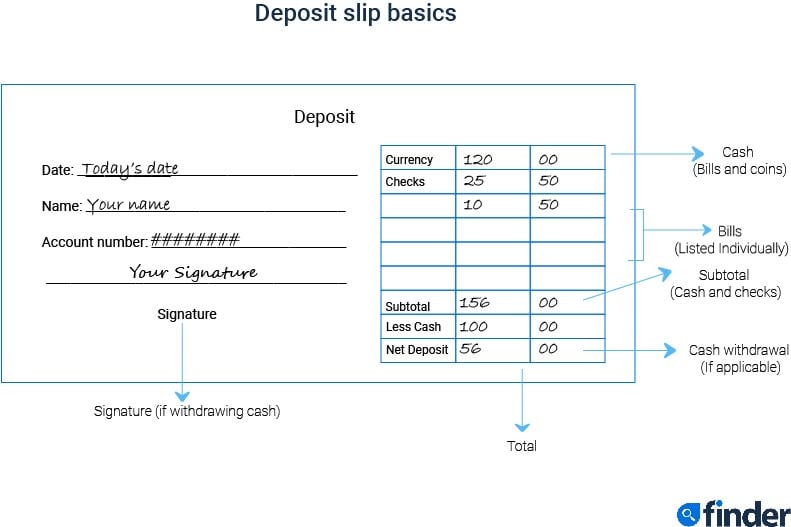Deposit slips are pretty universal among financial institutions, and they’re there to help the bank establish a written record of deposits and withdrawals done throughout the day. If you have a combination of cash and checks or multiple checks to deposit simultaneously at a branch, a deposit slip can be a way to get it done in one fell swoop.
How to fill out a bank deposit slip
It’s a straightforward process with five basic steps:
- Add your info. You’ll need your name and bank account number, which is usually between eight to 12 digits. You can find your account number in your checkbook, mobile banking app or by asking a teller after verifying your identity.
- Write the current date. Be sure to write the current date and not the date noted on any checks you’re depositing.
- Write the total amount of cash. If you’re depositing cash, enter the total dollar amount plus any change and endorse any checks you’re depositing. If you’re depositing multiple checks, write the amount of each one on a separate line on the slip.
- Determine your total. Write the subtotal of all your deposits, and if you’re not cashing any, your net deposit will be the same as your subtotal. If you’re cashing out some or all of the deposit, write how much you want withdrawn on the less cash line and subtract that from your subtotal to get your net deposit.
- Deposit the slip. Once you fill out the deposit slip, give it to the teller in the bank’s lobby or through the teller drive-thru along with the cash and/or checks you’re depositing.
And that’s it! Most banks offer deposit slips with clear lines to fill out. Just be sure to add up your subtotal and net deposit correctly, and you’ll likely need your ID to finish the process. Double-check all your information before handing it over to the teller as well.
Deposit slip example

Do I need to use a deposit split?
No, you don’t need a deposit slip to deposit a check or cash, and they’re not necessary when you visit a bank to deposit items. In fact, deposit slips are considered somewhat outdated, thanks to online banking. Other methods of depositing cash and checks include:
- Mobile check deposit. Most banks offer mobile check deposits with your banking app. It typically involves taking a picture of the check, entering the total amount and endorsing or signing the back of the check, similar to when you deposit a check via a bank deposit slip.
- ATM deposits. You can deposit cash or checks through your bank’s ATM, usually at no charge if you’re in-network. Simply insert your debit card, choose your deposit method, insert the cash or check and enter the deposit amount.
Keep in mind that mobile check deposits and ATM deposits may take a few days to clear, depending on the amount and your bank.
Is mobile check deposits safe?
Mobile check deposit is a somewhat newer feature offered by banks, so many likely feel uneasy using a feature like this for the first time — which is entirely fair considering everyone wants their money to be safe.
However, a mobile check deposit is considered a safe and secure transaction. When doing a mobile check deposit, your information is encrypted, which means your information is converted into data or a code to prevent unauthorized individuals from accessing your personal information. Also, you must be logged in to your mobile banking app to use a mobile check deposit feature, and you’ll receive confirmation and a receipt that the check was processed.
Compare top checking accounts
Narrow down top checking accounts by rates and minimum opening deposit to find the best for your budget and financial goals. Select Compare for up to four products to see their benefits side by side. And if you want a broader look at your options, compare checking accounts with multiple providers.
What is the Finder Score?
The Finder Score crunches over 300 checking accounts from hundreds of financial institutions. It takes into account the product's monthly fees, overdraft fees, opening deposit, customer support options, ATM network and features — this gives you a simple score out of 10.
To provide a Score, Finder’s banking experts analyze hundreds of checking accounts against what we consider is the best option: no monthly fees, no overdraft fees, a large ATM network of 50,000 or more, additional features outside of typical banking services, and the optional perk of earning interest. Accounts that are nearly free to maintain and use are scored the highest, while accounts with costly fees and few features are scored the lowest.
Frequently asked questions
How do you fill out a business deposit slip?
Business deposit slips are essentially the same as personal deposit slips, but business deposit slips typically have more lines to allow for a greater number of checks and also tend to have routing and account numbers preprinted on them.
Also, businesses may be able to deposit checks using a check scanner, depending on the bank. Cash, of course, still needs to be deposited in person or through a deposit box.
Are you supposed to bundle cash for a deposit at a bank?
It’s not necessary to bundle cash for a deposit. The bank puts the money through a counter, so you can bundle the cash for your own convenience, but bundling is not a necessary step to deposit large amounts of cash at the same time. If you want to stay organized, you can also put the cash in an envelope, and the bank teller will take it from there.
Image source: Getty Images
Ask a question
More guides on Finder
-
Are Premium Bank Accounts Worth the Money?
Premium means more perks, but they don’t make sense for everyone.
-
SoFi Plus Benefits and How It Works
SoFi Plus is a new membership option for SoFi customers that’s free with qualifying direct deposits and earns extra rewards and higher APYs.
-
Capital One Checking and Savings Bonuses of May 2025
See how to earn up to $1,500 when you open a new Capital One savings or checking account with qualifying deposits.
-
Axos Bank Bonus Offers in May 2025
The $500 Axos Bank bonus is now expired, but you can still earn $50 per qualifying referral, plus up to $400 with a new business account.
-
What Are the Benefits of Using Direct Deposit?
Benefits of direct deposit include: 1. It’s free, 2. You might get paid faster, 3. It’s convenient, 4. It’s environmentally friendly…
-
Discover® Savings Bonus Offers in May 2025
Discover only offers a bonus on its savings account, and it has a high deposit requirement. See how to get it here.
-
Fifth Third Bank promotions and bonus offers of May 2025
Fifth Third Bank currently offers a $325 checking account bonus when you open a new account and set up qualifying direct deposits.
-
SoFi Bonus Offers for May 2025
SoFi offers several bonus offers, including a direct deposit bonus, welcome offers and referral bonuses. See how to snag up to $300.
-
Federal Funds Rate History: 1954 to May 2025
Tracking the Fed funds rate from 1954 to now.
-
Compare 3-Way Joint Bank Accounts
You can open a joint bank account with three or more people. Learn how it works, how to sign up and what risks to be aware of.

